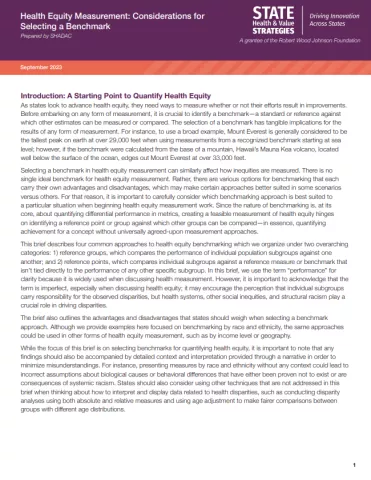The following content is cross-posted from State Health & Value Strategies.
Authors: Emily Zylla, Andrea Stewart, and Elizabeth Lukanen, SHADAC
As states look to advance health equity, they need ways to measure whether their efforts result in improvements. Benchmarking can be used to identify health disparities and establish a standard for evaluating efforts to address health inequities.
This issue brief summarizes the advantages and disadvantages of four common approaches to health equity benchmarking:
1) Using the best-performing group as a reference
2) Using the most socially advantaged group as a reference
3) Comparing against a population average
4) Comparing against a set target or goal
Key Findings
- There is no single ideal benchmark for health equity measurement and it is important to weigh the advantages and disadvantages of each before selecting an approach.
- The rationale for selecting a benchmarking approach should be thoroughly explained and accompanied by detailed context and interpretation, acknowledging the role of societal inequality and structural racism in driving disparities to prevent the perception that individual subgroups carry responsibility for the observed disparities.
Conclusion
There is no universal “best” approach to selecting a benchmark for health equity measurement. Ultimately, careful and detailed documentation of benchmarking methodology and other choices made in health equity measurement, paired with a discussion of the root causes of inequities, connects the dots between disparate outcomes and the disparities in power and privilege in which they are rooted to maintain the focus on the goal of advancing health equity.
To read the brief in its entirety click here.
About the Author/Grantee:
State Health and Value Strategies (SHVS) assists states in their efforts to transform health and healthcare by providing targeted technical assistance to state officials and agencies. The program is a grantee of the Robert Wood Johnson Foundation, led by staff at Princeton University’s School of Public and International Affairs. The program connects states with experts and peers to undertake healthcare transformation initiatives. By engaging state officials, the program provides lessons learned, highlights successful strategies and brings together states with experts in the field. Learn more at www.shvs.org.
This issue brief was prepared by Emily Zylla, Andrea Stewart, and Elizabeth Lukanen. The State Health Access Data Assistance Center (SHADAC) is an independent, multi-disciplinary health policy research center housed in the School of Public Health at the University of Minnesota with a focus on state policy. SHADAC produces rigorous, policy-driven analyses and translates its complex research findings into actionable information for states. Learn more at www.shadac.org.


